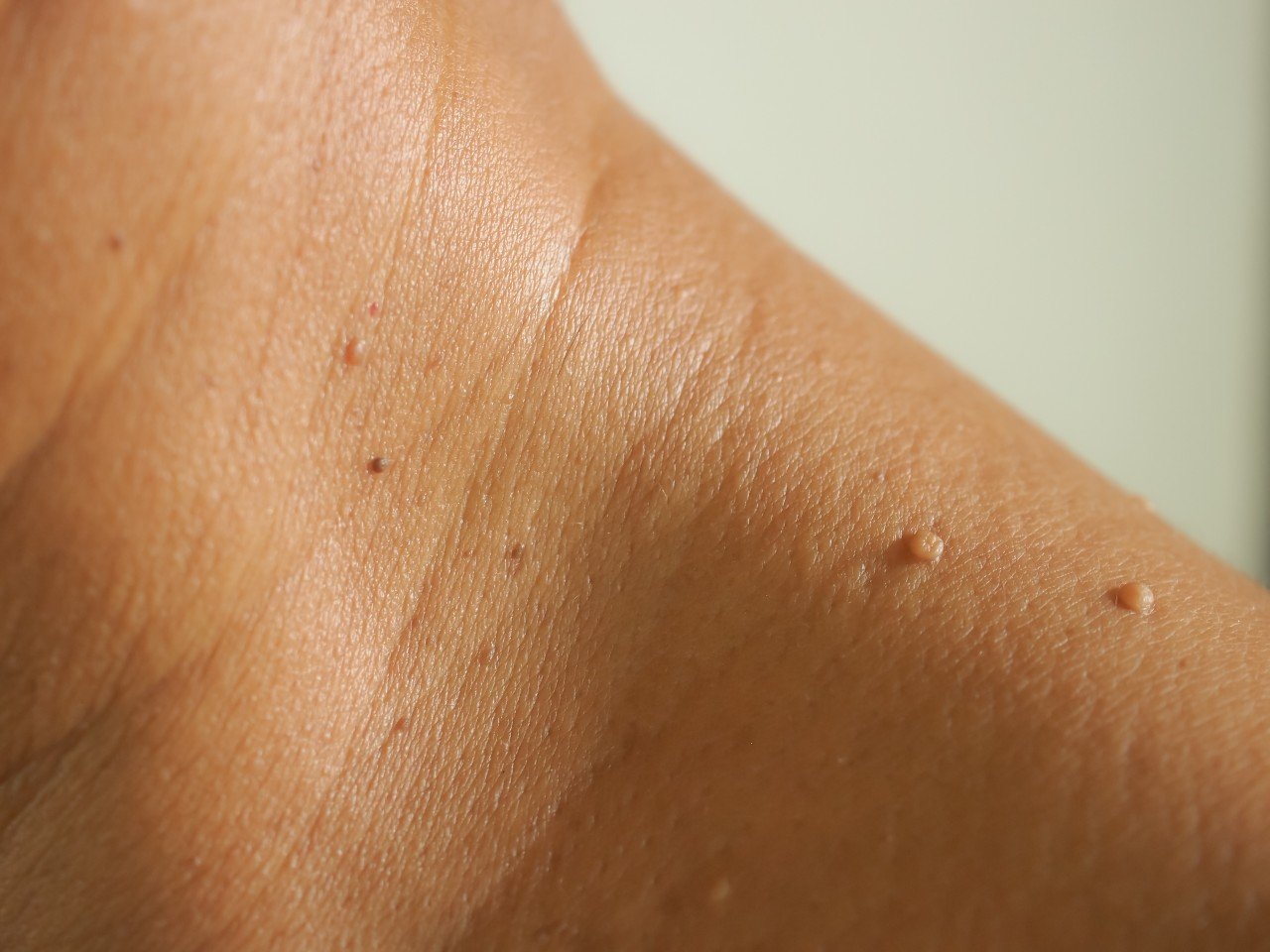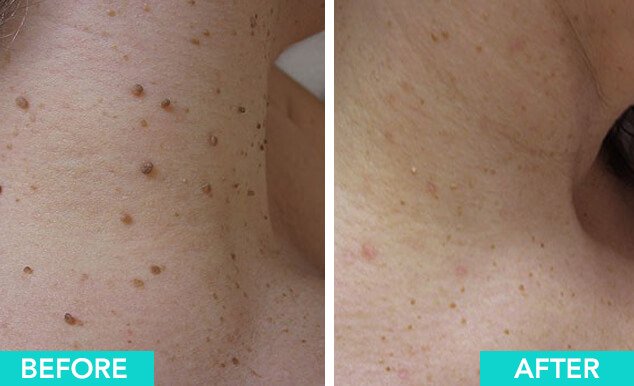
Call 305-340-9002 to schedule your consultation.
At Arviv Medical Aesthetics in Miami, we offer skin tag removal services to benefit the health and wellbeing of our clients. Our whole reason for being here is to help you look and feel your best. If you have skin tags, we understand that it can make you feel self-conscious. We want to get you back to being the strong, beautiful, confident person you were meant to be.
How Do Skin Tags Develop?
Skin tags develop as a stalk or peduncle attaches these benign growths of skin, collagen, and blood vessels. The good news is that skin tags are not dangerous or contagious. Since it is common for many in the same family to have them, genetics could herald an increased likelihood of developing them.
They are most common in bends and folds, so it is believed that friction may have something to do with skin tags’ development. They don’t discriminate against gender, age, or location, although they seem to be more common in those over 50. Both men and women can get them anywhere on the body, including:
- Eyelids
- Neck
- Groin
- Thighs
- Underarms
- Under breasts
Studies have shown some evidence that skin tag development can be related to the presence of the HPV virus, while others have indicated an increased risk in those with higher than recommended body mass index, increased triglycerides, and insulin resistance. Hormones may also play a role with an increase during pregnancy. Though rare, in some instances, skin tags could signal an endocrine issue or hormone imbalance.

How Will I Know If I Have a Skin Tag?
While you may mistakenly call a skin tag a mole, there is an easy way to tell the difference. A mole will be a raised area in the skin that is firmly attached. A skin tag is soft and hangs off the skin by the stalk. Though they can grow to several centimeters, most skin tags are smaller than two millimeters.
Not all skin tags look exactly alike. Some varying descriptions include:
- Smooth
- Round
- Wrinkly
- Asymmetrical
- Looks like a grain of rice
- Flesh-colored
- Darker than surrounding skin
Though skin tags aren’t inherently painful, they can get twisted, pulled, scratched, or scraped. The result could be minor tears or skin irritation that sting or hurt. If they bother you, it is easy to get them removed with painless skin tag removal.
What Options Are Available for Skin Tag Removal?
If looking for skin tag removal you have many options available to you. Although some skin tags may rub off without intervention, most do not. If you have one that is problematic or several that you would like to disappear, there are several options available.
Cryotherapy
Cryotherapy is a non-invasive treatment that freezes the tissue using liquid nitrogen. Once frozen, the tissue dies and falls off within one to two weeks. It is an accurate, effective, safe, and easy method of treating various skin lesions without damaging the surrounding skin.
Surgery
Sometimes your physician may recommend surgical removal. Excision can be done with surgical scissors or a scalpel and local anesthetic. If your dermatologist or surgeon wants to fully remove the stalk, they may have to cut into the surrounding tissue and close the incision with stitches or cauterization.
Electrosurgery
Another option for skin tag removal is electrosurgery. It burns off the skin tag using an electrical current and electrodes and also stops potential bleeding. The heat is generated from a range of voltage that can vary from 200 to 10,000 V. It travels through a wire and burns through the peduncle.
Ligation
Ligation is done by tying a fine surgical thread around the stem, cutting off the skin tag’s blood flow. Without a blood supply, the tissue dies and eventually falls off.
These methods are simple for any trained skin tag removal doctor and physicians because they have the tools and expertise to safely perform the procedures with minimal damage to the surrounding skin. Don’t be tempted to perform any removal procedures on your own. You may find many DIY suggestions for removing skin tags on the internet, but they are not recommended. You could end up causing more damage like bleeding, burns, or infection.
Safe, Easy Skin Tag Removal in Miami, FL
Skin growths like warts and moles could be mistaken for skin tags. Some moles can be cancerous, so you should have a dermatologist or physician examine them before considering any treatment. If they look suspicious, your doctor may want to perform a biopsy.
At Arviv Medical Aesthetics in Miami, we combine licensed medical treatment in a spa-like atmosphere. No matter what treatment looks like for you, you will experience the highest safety, comfort, and customer service.
For a consultation, please call our Miami office today at 305-340-9002. Please also see our other services here.
SKIN TAG REMOVAL MIAMI
Skin tags are small, benign tumors that form primarily in areas where the skin creases, such as the neck, armpit, and groin. This includes vaginal skin tag removal. They may also occur on the face, usually on the eyelids. Skin tags are harmless and typically painless, and do not grow or change over time. It is believed that skin tags occur from skin friction against the skin, since they are so often found in skin creases and folds.
All procedures can have side effects including, but not limited to, bruising, swelling, redness, pigmentation changes, and infection. Healing time varies from person to person and also depends on the type of procedure. If you have special events planned, you should plan 1-2 weeks in advance to allow healing time.

LESION REMOVAL INSTRUCTIONS
PRE-LESION REMOVAL INSTRUCTIONS
- Eat well during the weeks prior to surgery. Crash dieting, over-eating or high alcohol intake can greatly affect your overall health and well-being. A healthy, balanced diet is essential.
- Sun exposure can greatly affect the outcome of your procedure. Avoid any direct sun exposure to the area which will be treated and wear a SPF 30 daily even if the region to be treated is covered by clothing.
- Smoking can greatly impair your ability to heal. You must be nicotine and smoke-free for at least 4 weeks prior to surgery. You must also be free of any nicotine patch or nicotine-based products for a minimum of 4 weeks prior to surgery.
- Stop taking or using the following before your surgery: aspirin and medications containing aspirin, green tea or green tea extracts, ibuprofen and anti-inflammatory agents, estrogen supplements, Vitamin E, Retinoids, St. John’s Wort, Gingko, Garlic Supplements
POST-LESION REMOVAL INSTRUCTIONS
- Leave dressing in place for 24 hours then remove it and leave it off. (If the wound is in an area where it will get bumped or reinjured, you may put a light sterile gauze dressing over the wound for protection).
- Keep your wound clean and dry. Wash your wound daily with soap and water; pat dry carefully.
- Use ointment as instructed directly to site. If an antibiotic (by mouth) has been prescribed, take it as instructed.
- If sutures were used, clean around them once daily with Q-tips and peroxide; then follow the above protocol.
- Watch for signs of infection:
- Swelling
- Excessive redness
- Drainage
- Increasing pain
- Heat at the injury or an increase in temperature by thermometer.
- Loss of movement
- Return to have your sutures/stitches removed on the day instructed.
- Typical symptoms and signs to watch for following the excision of a skin lesion or skin tumor include the following: tingling, burning, redness, tightness at the surgical. These are normal experiences as the skin, tissues and sensory nerves heal. Consistent sharp pain should be reported to our office immediately.
Prices are subject to change and personalized prices will be provided upon consultation.
Featured Image: Shutterstock / Duangjan J